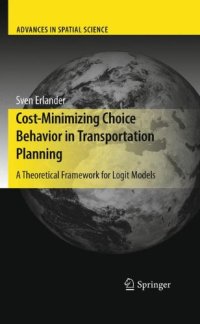
Ebook: Cost-Minimizing Choice Behavior in Transportation Planning: A Theoretical Framework for Logit Models
Author: Sven B. Erlander (auth.)
- Genre: Science (General)
- Tags: Regional/Spatial Science, Econometrics, Operations Research Mathematical Programming
- Series: Advances in Spatial Science
- Year: 2010
- Publisher: Springer-Verlag Berlin Heidelberg
- Edition: 1
- Language: English
- pdf
In the Administration building at Linkopi ¨ ng University we have one of Oscar Reutersvard’ ¨ s “Impossible Figures” in three dimensions. I call it “Perspectives of Science”. When viewed from a speci c point in space there is order and structure in the 3-dimensional gure. When viewed from other points there is disorder and no structure. If a speci c scienti c paradigm is used, there is order and structure; otherwise there is disorder and no structure. My perspective in Transportation Science has focused on understanding the mathematical structure and the logic underlying the choice probability models in common use. My book with N. F. Stewart on the Gravity model (Erlander and Stewart 1990), was written in this perspective. The present book stems from the same desire to understand underlying assumptions and structure. It investigateshow far a new way of de ning Cost-Minimizing Behavior can take us.Itturnsoutthatall commonlyusedchoiceprobabilitydistributionsoflogittype– log linear probability functions – follow from cost-minimizing behavior de ned in the new way. In addition some new nested models appear.
This book stems from a desire to understand the underlying assumptions and structure of the choice probability models most often used in transportation planning. The book investigates how far a new way of defining cost minimizing behavior can take us. All commonly used choice probability distributions of the logit type – log linear probability functions – follow from cost minimizing behavior defined in the new way; some new nested models also appear. The new approach provides a deeper understanding of what is at work in the models. The new way of defining cost minimizing behavior is as follows: cost minimizing behavior pertains if the likelihood (probability) of any independent sample of observations is a decreasing function of the average cost of the sample. Extreme value distributed random variables are not used in the derivation of models. A measure of freedom of choice related to the Shannon measure of how much "choice" is involved is used to obtain a welfare measure which is equal to composite cost.